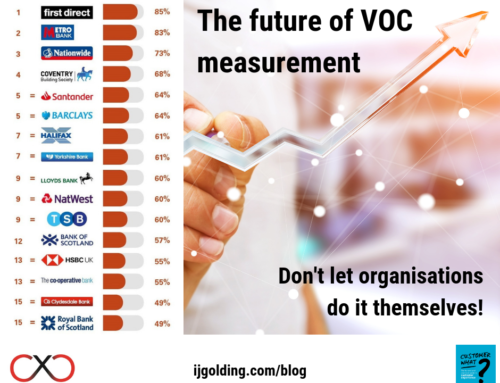In May 2012, I was fortunate enough to be able to present at the inaugural Customer Experience Strategy Summit in London. I was asked to speak on the subject of the customer experience (CX) measurement – a subject that is very close to my heart.
On Sunday, Business Reporter produced a special report on the state of CX from the learning’s at that conference. The report was produced for the Sunday Telegraph. Within the report, I highlight my ‘top tips’ for measuring the customer experience. This blog highlights what my tips are.
As the report rightly states, ‘organisations are pumping money into keeping the customer happy, but how do they know if they’ve got it right?’ Here are my top ten tips:
1. Know what you’re trying to achieve
It sounds obvious but the key thing is to understand exactly what you’re trying to find out from your customers so you can you pick the appropriate method and metric(s). What is it that you are trying to achieve? Different organisations have different objectives and there are different ways of measuring customer experience in order to achieve them. For some it’s Net Promoter Score, for others it’s CSAT surveys. If you don’t know what you want to measure, then gathering feedback from customers is obsolete as you won’t be able to appropriately use the data. It’s a waste of time and resources for you and your customer.
2. Work out what numbers you want
Once you’ve chosen a metric(s) to be the key driver for change, communicate the magic number to all staff and help put strategies in place to help them improve it. Communication is the key. The score should become a company Talisman of sorts. Everyone needs to know the number – although not necessarily the ins and outs of why it’s that number – and the detail behind that score will help govern and stimulate change across the board.
3. Get your facts right
Track the CX from start to finish so you can back up what colleagues believe, or assume, with concrete evidence. It’s important to determine what’s driving customer behaviour so you also know where to make changes. NPS alone won’t tell you this. For example, a negative score will only tell you something needs fixing – it doesn’t tell you what or where the “key moments of truth” are for your customer. Be prepared to bring in an additional metrics such as customer satisfaction (CSAT) surveys to help you drill down into the data. Also ensure that you are able to link what your customers think, with your own internal view of operational performance. Getting your facts right will ensure that you identify the right priorities for improvement.
4. Consider outsourcing your research
Think very carefully about the pros and cons of both outsourcing and using in-house services. In-house can be cheap, quick and simple to implement, but the down side is that it’s not independent. Outsourced agencies are more expensive, but will provide you with unbiased figures from experts in the field of customer research. Many are accredited by the Market Research Society, which may also give you more kudos with customers and directors alike.
5. Think like a customer
From a customer’s perspective, feedback forms can be complex, tedious and irrelevant, especially when they have no idea how you will use the information. But customer feedback is a crucial trigger for product and process improvements – so make this clear to customers and thank them for taking the time to tell you what they think.
6. Listen to what the customer is saying
Forms can be long and complicated and customers are often not told why they are being asked for their opinion or how the information will subsequently be used. How often do you go back and thank them or tell them how the information was used? Feedback is vital for improvements, and customers won’t realise this if you don’t tell them.
7. Stick to your guns
Choose the right metric for your organisation and stick to it until you have a body of data to work with. This doesn’t mean you can’t run measurements in parallel with one another – it will soon become clear which measurements are providing you with relevant and useful data that drives performance improvements.
8. Understand the numbers
Whatever the metric, you need to make certain that you understand the maths behind it, especially if you’ve outsourced to an agency. If you can’t explain it to your bosses, the data (and you) will lose credibility.
9. Don’t rest on your laurels
Customer expectations are changing all the time, so no matter how high your feedback ratings, be prepared to re-evaluate what you are doing for your customers. Question whether or not you’re making a difference and is that difference the right one for your customer.
10. Make customer service a priority for the whole company
CX metrics are now sophisticated enough to enable firms to report customer ratings to teams, process owners, and individuals. However, the metrics may not be relevant to everyone – especially support functions such as finance and HR. If you want your customer data to drive tangible improvements in CX, then that data has to be relevant to every single member of staff. If staff do not own or contribute to a process, they can certainly walk in the customers shoes and feel what it is like to be one.
You can access the full report via this link – http://business-reporter.co.uk/2012/07/customer-experience/
You can watch the recording of my presentation via this link – http://business-reporter.co.uk/2012/07/feel-the-pulse-of-your-people/
You are very welcome to comment on any of my blogs.







Are there any products for CX measurement that you would recommend? I found http://cxbenchmark.com, but it looks like they are closed to new users and so wondering if there are other good alternatives in this space.
Hi John. From a product perspective, it all depends what you want to achieve, and what your circumstances are. If you want to email me at ijgolding@hotmail.com, detailing your objectives, I’ll do my best to suggest the right direction…